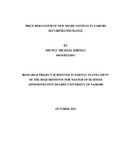| dc.description.abstract | This study examines the price performance of initial public offerings (IPOs) in the Nairobi Securities Exchange (NSE) during the period 2006-2011. It investigates the difference between the IPOs listing price and their equilibrium market price through studying a sample of 10 new listed companies. Specifically, it examines the differences between the listing price of IPOs and their equilibrium market prices at the end of the first day, second, third, sixth, ninth, twelfth and fifteenth month. From the derived results it is evident that Nairobi Securities Exchange IPOs have large positive initial returns, especially on the end of the first trading day. The short term performance has been analysed using the Market Adjusted Abnormal Returns (MAAR) while long term performance has been analysed using Wealth Relatives (WRs) and Buy and Hold Abnormal Returns (BHARs). Further, the relationship between the subscription rate and share returns has been evaluated using regression model. Short term results indicate an over-performance of 61.46 per cent. Long term results for investors who bought the shares during offer period, are much lower than initial day‟s returns and in some cases even underperforming the market. The long term results for investors who bought the shares during listing day are all negative indicating high underperformance. Both these trends are in agreement with the outcomes of international empirical studies. The first day under-pricing phenomenon forces to search for possible factors, which may have caused it. Different variables, used in similar international studies were used to do so. Our research shows that positive initial returns, amongst other factors, may have been affected by time period for issuing the share (hot issue or cold issue), the firms issue size and the proceeds of issue. The rate of subscription does not affect the returns as per the results | en |

